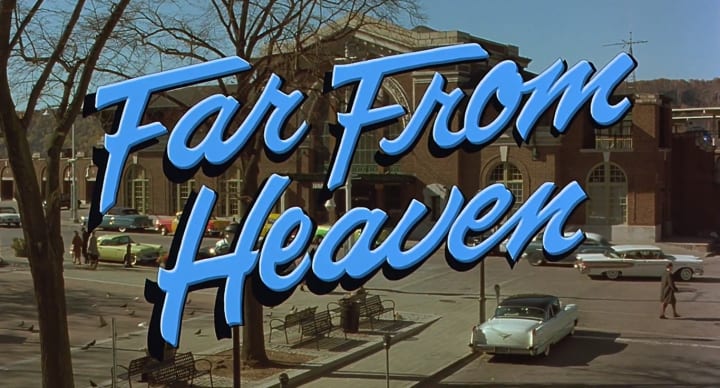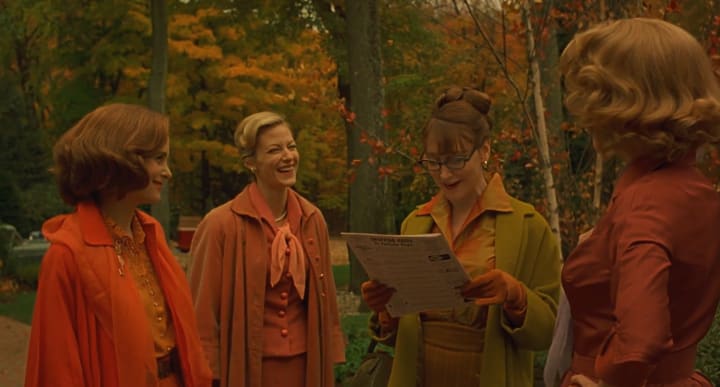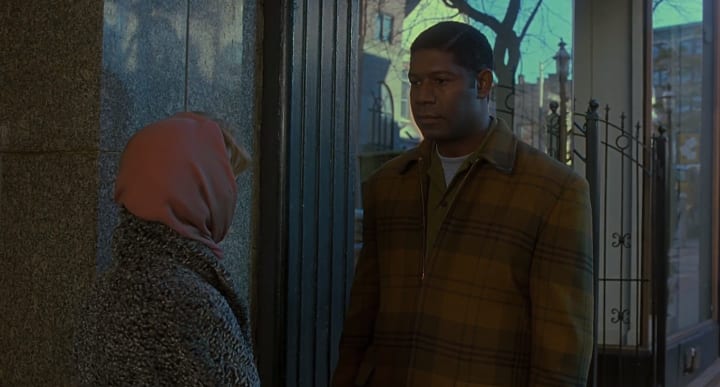Director Todd Haynes Mise-en-scène Choices in 'Far From Heaven' (Film)
2002 period drama starring Julianne Moore and Dennis Quaid

Read Time: 15 minutes excluding videos
Something Different
A lot of the content I post is marketing-related, but from time to time I like to express my other interest or area of study: film and/or television! I graduated from university with a Double Degree in Marketing and Screen Arts.
If you're interested in films, film analysis, filmmaking, film theory, screenwriting, directing, creative processes, visual studies, photography, sound design, dramas, melodramas, actress Julianne Moore, actor Dennis Quaid, or director Todd Haynes...then you'll most likely enjoy this Vocal Story!
Follow Me on Instagram: @perthmarketer
Follow me on Instagram to check out my other content.
Also, if you're a fan of Todd Haynes films, shoot me a message on Instagram and answer this: What's your favourite Todd Haynes film so far?
Follow Me on Facebook: @perthmarketer
Before We Begin: Send Me a Small One-off Gift
If you enjoy how I analyse Far From Heaven, then right at the bottom of your screen or of this blog you might like to send me a small one-off gift (it's in USD) or share the blog link on your own social media platform (Facebook, LinkedIn, etc). Either one will brighten my day!
At the very bottom it'll look like this:

WARNING: Spoilers Below
Let's begin:

The mise-en-scène choices a director makes depends on the effect he/she wants to achieve moment by moment, scene by scene. In this Vocal Story I will be analysing Far From Heaven directed by Todd Haynes. Specifically I will be exploring how the director’s vision was created through the manipulation of key elements of form and style for dramatic effect with reference to: lighting, sound design, framing, setting colour, as well as costume colour.

ABOUT THE FILM
Far from Heaven is a 2002 American period drama film written and directed by Todd Haynes, starring Julianne Moore and Dennis Quaid. The film tells the story of Cathy Whitaker (Moore), a 1950s housewife married to Frank Whitaker (Quaid), living in wealthy suburban Connecticut as she sees her seemingly perfect life begin to fall apart.

Haynes pays homage to the 1950s films of Douglas Sirk exploring race, gender roles, sexual orientation, and class in the context of 1950s America. Watch the trailer linked below:
Want to know where you can watch the film? I've listed some platforms at the end.
LIGHTING
Much of the impact of an image comes from the manipulation of lighting (Bordwell and Thompson 2013). Far From Heaven has a lot more lighting variety compared to other films of its time. Haynes uses unnatural and bright lighting to depict marital dysfunction. Far From Heaven takes place over several seasons and the ambient night light changes as the seasons change; which is a metaphor for what the characters are experiencing emotionally. For the autumn scenes in the beginning, the night light is a lavender or periwinkle blue, but as Cathy and Frank’s relationship deteriorates, the night light becomes a brighter blue [as shown below].


Far From Heaven almost seems especially made to prove right one of the masters of film lighting, Josef von Sternberg, when he remarked: "The proper use of light can embellish and dramatize every object," (Bordwell and Thompson 2013).
SOUND DESIGN
In Far From Heaven a highly evocative musical score plays beneath almost every scene putting the ‘melody’ in this ‘melodrama’ - Melodrama literally translates to ‘music’ and ‘drama’. The swooping score provides “a more nuanced musical palette than we are accustomed to: it alternates among distinct solo piano, woodwind, and full orchestral passages,” (Willis 2003). Likewise, in its volume, “it often obtrudes aggressively into the affective tonality of the unfolding sequences,” (Willis 2003). Listen to the musical score titled Autumn In Connecticut below.
Right from the opening scene the music evokes a gradual disintegration of perfection and the forced attempts to hold on to something that will inevitably crumble. For example, the scene immediately following the dinner party effectively employs music to sensationalize the image. The deep extravagantly emotional strings slowly build and at the moment Frank strikes Cathy’s face the music climaxes, creating for the audience feelings of shock, anger and disgust.
FRAMING
In cinema, “framing is not simply a neutral border; it imposes a certain vantage point onto the material within the image - it actively defines the image for us,” (Bordwell and Thompson 2013). In Far From Heaven Cathy isn’t framed like women are today. Women today tend to have a sturdy dominance of the frame, whereas Cathy is diminished by the frame. Cathy especially is often confined to the frame as she is filmed through a multitude of diegetic frames or ‘frames within frames’ (windows, doorways, mirrors, etc.), which indicates how imprisoned she is within suburbia [as shown below].

Not only do these devices give the impression that Cathy is trapped, caged by her environment, but also that she is isolated, confined and oppressed by her lonely world (Rogers 2012). The mise-en-scène is richly symbolic and so meticulously crafted to show how homes that are meant to be havens can become claustrophobic prisons (Simmons 2005).

Far from Heaven often unexpectedly inserts a canted frame or Dutch angle, which is framing that is tipped to one side or the other, and is relatively rare (Bordwell and Thompson 2013). “Regularly marking brutal shifts in perspective, the canted frame brusquely forces us into a different ‘angle of view’, as it punctures the diegetic surface and disrupts the melodramatic atmosphere,” (Willis 2003). A canted frame seems to suggest that “the world is out of kilter,” (Bordwell and Thompson 2013). A powerful example is the way in which the film imitates Cathy’s shocked reaction to seeing her husband kissing someone else in his office through the canted frame that captures her leaving (Willis 2003).

Apart from their narrative significance, framings can add a visual interest of their own. By having an unusual and striking angle, the director forces the spectator to take a keener interest which goes beyond mere noticing or acceptance (Bordwell and Thompson 2013).
SETTING & COSTUME COLOUR
Colour plays an important role in Far From Heaven…Far From Heaven is a movie about the 50’s and pays homage to some of the great movies of the 50’s, in particular the technicolour melodramas that the great German director Douglas Sirk made. Haynes pays meticulous attention to colour to help articulate forbidden feelings in ways dialogue cannot, and in that way he is a true devotee of Sirk. But, Haynes was interested both in updating Sirk and in reproducing his brilliant scintillating style - appropriating Sirk’s style by applying his visual terminology. Haynes borrows most from Sirk's 1955 weepie All That Heaven Allows by flooding the screen with colour, giving it a hyper-reality effect. Haynes organized the colour palette around two sets of contrasts: cool/warm tones, and red/green tones. There’s no direct correlation in the sense of this colour designates this emotion, it’s really more about the interplay of the colours. The colourfully rich world Haynes constructs in Far From Heaven straddles a fine line between natural and artificial, which is at times hypnotizing.
As significant as colour is in lighting, it is even more telling of narrative changes and unspoken developments, in the film's costumes. It is worthwhile examining four of Cathy's costumes in terms of their colour and their place in the narrative. In an early scene, Cathy and her friends stand in her front yard [shown below]. All four are dressed in autumn hues - various shades of red, orange, brown and yellow - which literally blend in with their surroundings (Rogers 2012).

This colour blending is “an exaggerated replica of a common Sirk effect: by keying a woman’s clothing to the setting, Sirk merges her into her environment,” (Willis 2003). The outfit Cathy wears for Frank’s first visit to the doctor [shown below] is also striking because it bleeds into the setting (Bordwell and Thompson 2013) - Her gorgeously put together outfit offer a subtle range of bluish and purplish tones that harmonize perfectly with the colour scheme of the doctor’s waiting room (Willis 2003).

In the scene the morning after Frank strikes Cathy, Eleanor and Cathy are dressed in noticeably contrasting colours [shown below], and this is the first time that their clothes don’t match or harmonize (Willis 2003). In her brown blouse, Eleanor rhymes with the autumnal trees behind her (Willis 2003). Cathy’s attire, however, introduces a striking visual disharmony. She wears a lavender sweater over a minty green dress.

This scene and the marked change in Cathy's costume colour signifies a turning point in Cathy's narrative arc - “that of her increasing divergence from, and discontent with, the unspoken rules and expectations of her society” (Rogers 2012). Finally, in a poignant scene towards the conclusion of Far from Heaven where Cathy tells Raymond she cannot see him anymore [shown below] because of the gossip and trouble their friendship is bringing her family, she is dressed in a dull grey, mottled jacket, which seems to blend into the cement wall behind her (Rogers 2012). Cathy's clothes speak both of the hopelessness of their friendship, and of her desire to literally blend in with society (Rogers 2012).

Although Cathy’s colour palette is vast, vivid and volatile in relation to the environment…the colour contrasts in the film aren’t huge, because we’re extremely sensitive to small differences (Bordwell and Thompson 2013). Each scene tends to have what is called a ‘limited palette’ or ‘monochromatic colour design’ whereby “the director emphasizes a single colour varying it only in purity or lightness,” (Bordwell and Thompson 2013). Mentioned above are examples of monochromatic mise-en-scène when the women gather outside and also when Cathy waits in the doctor’s waiting room.

In monochromatic mise-en-scène the slightest fleck of a contrasting colour (such as Cathy’s lavender scarf shown above) will catch the viewer’s attention and suggest that this change in colour is loaded with meaning and is an important part of the narrative (Bordwell and Thompson 2013). Colours take on roles in the film: blue is used to articulate isolation, sadness and desolation; red represents passion, anger and trouble; green is used to convey a lurid, sickly eeriness; and lavendar represents the deterioration of Cathy and Frank's relationship (Rogers 2012).
Similarities Between 'Far From Heaven' and Other Haynes Films:
Creative Collaborations
In 1995 Haynes collaborated with actress Julianne Moore for the first time in a movie called Safe which is set in 1987 and follows a suburban housewife in Los Angeles whose monotonous life is abruptly changed when she becomes sick with a mysterious illness caused by the environment around her - Watch the trailer below:
He then collaborated with her for Far From Heaven in 2002, and again for Wonderstruck in 2017. Watch Haynes and Moore talk about the films and their creative collaborations in the video linked below:
“Far From Heaven was really a script that I wrote with you utterly in mind from the beginning…” - Todd Haynes says about Julianne Moore
“The amazing thing about Sirk is he always had those false happy endings...where his films would do this certain amount of labour to expose the problems of social settings and the pressures on individuals, and they would sort of be crushed by those pressures and succumb to them, and then finally little quick resolutions would occur at the end...and it was a happy ending that you never trusted, it never felt like it could ever be sufficient to make up for the thing that he so beautifully had exposed in the course of the film….Safe really does have the false happy ending, that I never really got as close to again, where I really tip the hat to Sirk who did so well...” - Todd Haynes talking about Sirk, Safe and Far From Heaven.
Psychotherapy
In Far From Heaven Carol’s husband goes for psychotherapy sessions, and in Safe the main character is recommended psychotherapy sessions. What’s fascinating is that people among the psychoanalytic community seem to discuss Haynes' work quite a lot, in particular his film Safe. In other words, Haynes is using psychoanalysis in his work, and psychoanalysts are using Haynes in their work - And a fun fact: Haynes is actually an avid reader of Freud’s work. Rumor has it that Haynes is actually taking on a mini-series about Freud with Amazon Studios. Time will tell if this mini-series comes to fruition.
Character Names
In both Far From Heaven (2002) and Carol (2015), the main character is named “Carol”.
Settings
Like Far From Heaven, the majority of Haynes films are set in the past. Haynes seems to have a particular passion for representing the past.
Fragility
Like Far From Heaven, many of Haynes' films follow a desperate fragile suburban housewife - For example Safe and Carol are both about housewives or women's worlds. In a 2003 interview about Far From Heaven linked below, Haynes says:
“I love these films that are about these women's worlds that were directed to a female audience as ‘their’ movie, you know, ‘their’ kind of stories….but they’re really about these very fragile people who, you know, can’t break out of their societies…”
CONCLUSION
As we can see in Far From Heaven lighting, sound design, framing, and colour have all been manipulated for a dramatic effect. Haynes uses a lot of unnatural bright lighting, a constant musical score, canted frames, and lastly he relies heavily on colour to create a hyper-reality melodramatic effect. Apart from Haynes’ form and style inspired by Sirk, his films have a lot of similarities in terms of creative collaborations, subject matter, characters, and settings which is noteworthy but not surprising. In the process of creating this blog or story, Haynes has become a fascinating film director in my mind, and I’m hoping that his project about Freud comes to fruition.

Where to Watch 'Far From Heaven':
Below I've listed/linked [in no particular order] where to watch Far From Heaven. However, if you're reading this months after I've posted it, then some or all of the information provided below may have changed.
Watch on Kanopy - Start watching for free with your public library card or university login
Watch on Amazon Prime Video (America Only) - 7 day free trial, USD$10.99 per month after
Rent on Amazon (America Only) - USD$3.99 HD
Buy on Amazon (America Only) - USD $13.99 HD
Send Me a Small One-off Gift
It took me a lot of time to piece this together. Hopefully you enjoyed reading it as much as I enjoyed writing it! If you truly enjoyed it, then perhaps you'd like to send me a small one-off gift (it's in USD)—you should see that option right at the bottom. Or, perhaps you'd like to share the blog link on your own social media (Facebook, LinkedIn, etc).
What To Read Next
You might like to read my other blogs/stories:
A Closer Look at 'Under the Skin’s' (Film) Mise-en-scène & Marketing Choices
Visual Analysis: How ‘Nightcrawler’ (Film) Challenges Voyeurism
Unpacking 'Patrick Melrose' (TV Mini-Series)
Call Me
Book a clarity call with me to discuss anything marketing or film-related.
References:
Bordwell, David, and Kristin Thompson. 2013. Film Art: An Introduction. Boston: McGraw-Hill.
Rogers, Simon. 2012. "Paradise is Burning: Expressing the Unspeakable through Melodrama in all that Heaven Allows and Far from Heaven." Screen Education (66): 90-98. https://search-proquest-com.dbgw.lis.curtin.edu.au/docview/1282119623?accountid=10382.
Simmons, Gary. 2005. "Paradise Lost: Far From Heaven." Screen Education (40): 103-107. https://search-proquest-com.dbgw.lis.curtin.edu.au/docview/236686326?accountid=10382.
Willis, Sharon. 2003. "The Politics of Disappointment: Todd Haynes Rewrites Douglas Sirk." Camera Obscura (54): 130-175. https://search-proquest-com.dbgw.lis.curtin.edu.au/docview/217544216?accountid=10382.
About the Creator
Perth Marketer
🎬 Movies & Marketing 🍿
Helping small businesses with their digital marketing & exploring the magic of movies
Follow on Instagram: @perthmarketer
Follow on Facebook: Perth Marketer






Comments
There are no comments for this story
Be the first to respond and start the conversation.